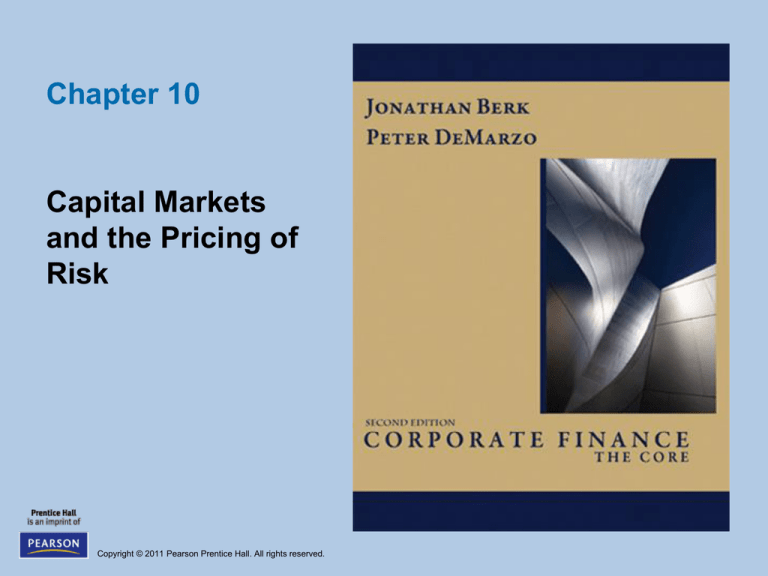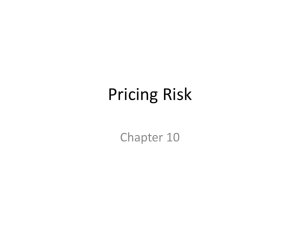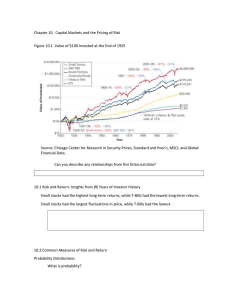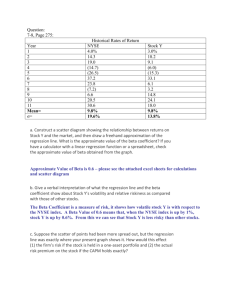
Chapter 10
Capital Markets
and the Pricing of
Risk
Copyright © 2011 Pearson Prentice Hall. All rights reserved.
Figure 10.1 Value of $100 Invested at the
End of 1925
Source: Chicago Center for Research in Security Prices (CRSP) for U.S. stocks and CPI, Global
Finance Data for the World Index, Treasury bills and corporate bonds.
5-2
10.2 Common Measures
of Risk and Return
• Probability Distribution
When an investment is risky, there are different returns
it may earn. Each possible return has some likelihood
of occurring. This information is summarized with a
probability distribution, which assigns a probability, PR ,
that each possible return, R , will occur.
• Assume BFI stock currently trades for $100 per share.
In one year, there is a 25% chance the share price will be
$140, a 50% chance it will be $110, and a 25% chance it
will be $80.
5-3
Table 10.1
5-4
Figure 10.2 Probability Distribution
of Returns for BFI
5-5
Expected Return
• Expected (Mean) Return
Calculated as a weighted average of the
possible returns, where the weights correspond
to the probabilities.
Expected Return E R
R
PR R
5-6
Variance and Standard Deviation
• Variance
The expected squared deviation from the mean
2
Var (R) E R E R
R
PR
R
E R
2
• Standard Deviation
The square root of the variance
SD( R)
Var ( R)
• Both are measures of the risk of a probability
distribution
5-7
Alternative Example 10.1
• Problem
TXU stock is has the following probability distribution:
Probability
Return
.25
8%
.55
10%
.20
12%
What are its expected return and standard
deviation?
5-8
Alternative Example
• Solution
Expected Return
• E[R] = (.25)(.08) + (.55)(.10) + (.20)(.12)
• E[R] = 0.020 + 0.055 + 0.024 = 0.099 = 9.9%
Standard Deviation
• SD(R) = [(.25)(.08 – .099)2 + (.55)(.10 – .099)2 +
(.20)(.12 – .099)2]1/2
• SD(R) = [0.00009025 + 0.00000055 + 0.0000882]1/2
• SD(R) = 0.0001791/2 = .01338 = 1.338%
5-9
10.3 Historical Returns
of Stocks and Bonds
• Computing Historical Returns
Realized Return
• The return that actually occurs over a particular time period.
Rt 1
Divt 1 Pt 1
Pt
Divt 1
Divt 1 Pt
1
Pt
Pt
Dividend Yield Capital Gain Rate
5-10
10.3 Historical Returns
of Stocks and Bonds (cont'd)
• Computing Historical Returns
If a stock pays dividends at the end of each quarter,
with realized returns RQ1, . . . ,RQ4 each quarter, then its
annual realized return, Rannual, is computed as:
1 Rannual (1 RQ1 )(1 RQ 2 )(1 RQ 3 )(1 RQ 4 )
5-11
Chapter 10, problem 6
Using the data in the table below, calculate the
return for investing in Boeing stock from January
2, 2003 to January 2, 2004, assuming all
dividends are reinvested in the stock immediately.
Date
Price
Dividend
1/2/03
33.88
2/5/03
30.67
0.17
5/14/03
29.49
0.17
8/13/03
32.38
0.17
11/12/03
39.07
0.17
1/2/04
41.99
5-12
Figure 10.4 The Empirical Distribution of Annual
Returns for U.S. Large Stocks (S&P 500), Small Stocks,
Corporate Bonds, and Treasury Bills, 1926–2008
5-13
Average Annual Return
1
R
T
R1
R2
RT
T
1
Rt
T t 1
Where Rt is the realized return of a security in year t, for
the years 1 through T
• Using the data from Table 10.2, the average annual return
for the S&P 500 from 1996–2004 is:
R
1
(0.230 0.334 0.286 0.210 0.091
9
0.119 0.221 0.287 0.109) 11.4%
5-14
The Variance and Volatility of Returns
• Variance Estimate Using Realized Returns
1
Var (R)
T 1
T
R
t 1
t
R
2
The estimate of the standard deviation is the square
root of the variance.
5-15
Table 10.3 and 10.4:
Return and volatility, 1926–2008
5-16
Using Past Returns to Predict the Future:
Estimation Error
• We can use a security’s historical average return
to estimate its actual expected return. However,
the average return is just an estimate of the
expected return.
Standard Error
• A statistical measure of the degree of estimation error
Example: The expected return and standard deviation of the
S&P 500 annual return was 12.36% and 20.36%,
respectively. Given that that these empirical estimates were
calculated based on the past 79 years(1926–2004), what is
the 95% confidence interval for next year’s S&P 500 return?
What is the probability that return will go down by more than
5-17
5%?
Table 10.5 Volatility Versus Excess Return of U.S.
Small Stocks, Large Stocks (S&P 500), Corporate
Bonds, and Treasury Bills, 1926–2008
5-18
Figure 10.5 The Historical Tradeoff Between Risk
and Return in Large Portfolios, 1926–2005
Source: CRSP, Morgan Stanley Capital International
5-19
Figure 10.6 Historical Volatility and Return for 500
Individual Stocks, by Size, Updated Quarterly, 1926–
2005
5-20
10.5 Common Versus Independent Risk
The Vancouver insurance industry is highly competitive.
Manulife has 100,000 houses insured against theft, and
100,000 houses insured against earthquake. Against a
year with large claims of above $100M, the company can
reinsure itself with a reinsurance company in Swiss at a
premium of 1% of claim value.
Suppose that in Vancouver there is a 0.1% probability of a
theft and a 0.1% probability of an earthquake in any given
year. If an average house in the city costs $600,000, what
would you expect the premiums to be for each type of
insurance given that the competitive market is such that in
95% of the years the insurance company’s revenues are
higher than the costs of claims?
5-21
10.5 Common Versus Independent Risk
Common Risk and Independent Risk in the
Corporate Environment
Risk that affects all securities versus risk that
affects a particular security.
Diversification – the process of averaging out of
independent risks in a large portfolio
5-22
10.6 Diversification in Stock Portfolios
• Firm-Specific Versus Systematic Risk
Firm Specific News
• Good or bad news about an individual company
Market-Wide News
• News that affects all stocks, such as news about
the economy
5-23
10.6 Diversification in Stock Portfolios
Important financial terminology
Independent Risks
• Due to firm-specific news
Also known as:
Common Risks
• Due to market-wide news
Also known as:
» Firm-Specific Risk
» Systematic Risk
» Idiosyncratic Risk
» Undiversifiable Risk
» Unique Risk
» Market Risk
» Unsystematic Risk
» Diversifiable Risk
5-24
10.6 Diversification
in Stock Portfolios (cont'd)
• Firm-Specific Versus Systematic Risk
When many stocks are combined in a large portfolio,
the firm-specific risks for each stock will average out
and be diversified.
The systematic risk, however, will affect all firms and
will not be diversified.
5-25
10.6 Diversification in Stock Portfolios
• Firm-Specific Versus Systematic Risk
Consider two types of firms:
• Type S firms are affected only by systematic risk. There is a
50% chance the economy will be strong and type S stocks
will earn a return of 40%; There is a 50% change the
economy will be weak and their return will be –20%.
Because all these firms face the same systematic risk,
holding a large portfolio of type S firms will not diversify
the risk.
• Type I firms are affected only by firm-specific risks. Their
returns are equally likely to be 40% or –20%, based on
factors specific to each firm’s local market. Because these
risks are firm specific, if we hold a portfolio of the stocks of
many type I firms, the risk is diversified.
5-26
Example 10.6
5-27
Figure 10.7 Volatility of Portfolios
of Type S and I Stocks
5-28
No Arbitrage and the Risk Premium
• The risk premium for diversifiable risk is zero, so
investors are not compensated for holding firmspecific risk.
If the diversifiable risk of stocks were compensated with
an additional risk premium, then investors could buy the
stocks, earn the additional premium, and
simultaneously diversify and eliminate the risk.
5-29
No Arbitrage
and the Risk Premium (cont'd)
• The risk premium of a security is determined by
its systematic risk and does not depend on its
diversifiable risk.
This implies that a stock’s volatility, which is a measure
of total risk (that is, systematic risk plus diversifiable
risk), is not especially useful in determining the risk
premium that investors will earn.
5-30
10.7 Measuring Systematic Risk
• Estimating the expected return will require
two steps:
Measure the investment’s systematic risk
Determine the risk premium required to compensate for
that amount of systematic risk
5-31
Measuring Systematic Risk (cont'd)
• Efficient Portfolio
A portfolio that contains only systematic risk. There is
no way to reduce the volatility of the portfolio without
lowering its expected return.
• Market Portfolio
An efficient portfolio that contains all shares and
securities in the market
• The S&P 500 is often used as a proxy for the
market portfolio.
5-32
Measuring Systematic Risk (cont'd)
• Beta (β)
The expected percent change in the excess return of a
security for a 1% change in the excess return of the
market portfolio.
• Beta differs from volatility. Volatility measures total risk
(systematic plus unsystematic risk), while beta is a measure
of only systematic risk.
5-33
Chapter 10, problem 31
Suppose the market portfolio is equally likely to increase
by 30% or decrease by 10%.
a. Calculate the beta of a firm that goes up on average by
43% when the market goes up and goes down by 17%
when the market goes down.
b. Calculate the beta of a firm that goes up on average by
18% when the market goes down and goes down by
22% when the market goes up.
c. Calculate the beta of a firm that is expected to go up
by 4% independently of the market.
5-34
Measuring Systematic Risk (cont'd)
• Beta (β)
A security’s beta is related to how sensitive its
underlying revenues and cash flows are to general
economic conditions. Stocks in cyclical industries, are
likely to be more sensitive to systematic risk and have
higher betas than stocks in less sensitive industries.
5-35
Table 10.6 Betas with
Respect to the S&P 500
for Individual Stocks
(based on monthly data
for 2004–2008)
5-36
Estimating the Risk Premium
• Market Risk Premium
The market risk premium is the reward investors expect
to earn for holding a portfolio with a beta of 1.
Market Risk Premium E RMkt rf
5-37
Estimating the Risk Premium (cont'd)
• Estimating a Traded Security’s Expected Return
from Its Beta
E R Risk-Free Interest Rate Risk Premium
rf (E RMkt rf )
5-38
Example
• Problem
Assume the economy has a 60% chance of the market
return will 15% next year and a 40% chance the market
return will be 5% next year.
Assume the risk-free rate is 6%.
If Microsoft’s beta is 1.18, what is its expected
return next year?
5-39
10.8 Beta and the Cost of Capital
• A firm’s cost of capital for a project is the
expected return that its investors could earn on
other investments with the same risk.
Systematic risk determines expected returns, thus the
cost of capital for an investment is the expected return
available on securities with the same beta.
• The cost of capital for investing in a project is:
r rf (E RMkt rf )
5-40
Example
5-41
How the CAPM is related capital market
efficiency
• Efficient Capital Markets
When the cost of capital of an investment depends only
on its systematic risk and not its unsystematic risk.
• The CAPM states that the cost of capital of any investment
depends upon its beta. The CAPM is a much stronger
hypothesis than an efficient capital market. The CAPM
states that the cost of capital depends only on systematic
risk and that systematic risk can be measured precisely by
an investment’s beta with the market portfolio.
5-42
Empirical Evidence
on Capital Market Competition
• If the market portfolio were not efficient, investors
could find strategies that would “beat the market”
with higher returns and lower risk.
• However, all investors cannot beat the market,
because the sum of all investors’ portfolios is the
market portfolio.
• Hence, security prices must change, and the
returns from adopting these strategies must fall
so that these strategies would no longer “beat
the market.”
5-43
Empirical Evidence
on Capital Market Competition (cont'd)
• An active portfolio manager advertises his/her
ability to pick stocks that “beat the market.” While
many managers do have some ability to “beat the
market,” once the fees that are charged by these
funds are taken into account, the empirical
evidence shows that active portfolio managers
have no ability to outperform the market portfolio.
5-44







